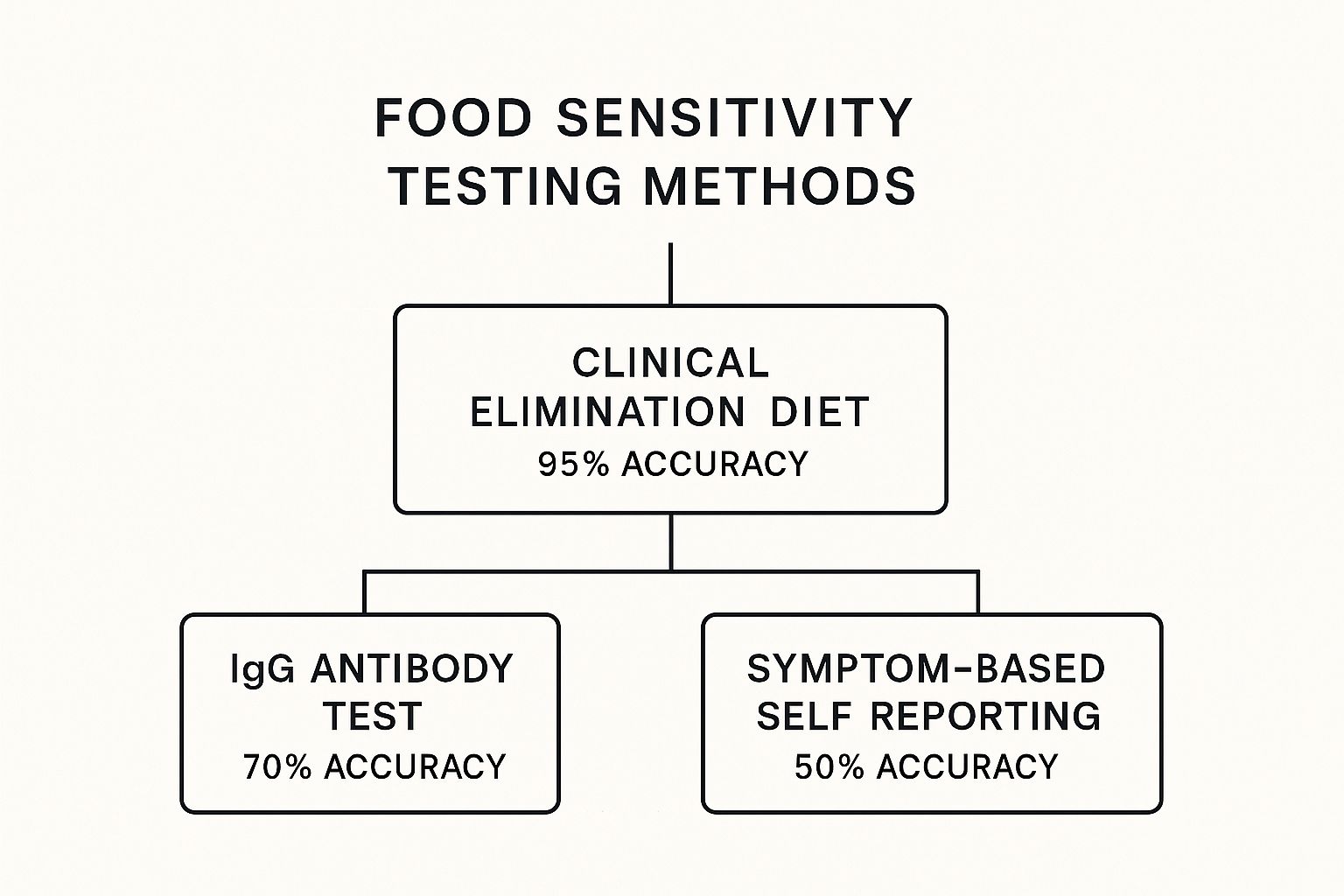
Trying to figure out if a food sensitivity test is accurate can feel like navigating a maze. The truth is, "accuracy" isn't a simple yes-or-no question here. A test's reliability hinges on what type of test it is, what it’s actually measuring, and your own unique body chemistry. It’s this complexity that stirs up so much debate, especially around at-home test kits.
What "Accuracy" Really Means for Food Sensitivity Tests

When you feel bloated, exhausted, or just plain "off" after eating, getting to the root of the problem becomes your number one mission. This has fueled a massive boom in at-home food sensitivity tests. But before you prick your finger, it’s crucial to understand what these tests can—and more importantly, cannot—tell you.
Many of the most popular kits measure something called IgG antibodies. The problem? We often misinterpret what those antibodies mean. Seeing IgG antibodies to a food doesn't automatically signal a sensitivity. It can simply mean you’ve eaten that food recently, and your immune system is doing its normal job. It’s a sign of exposure, not necessarily a problem.
This is where the medical community is divided. While some studies hint at a connection between high IgG levels and certain symptoms, major allergy organizations warn against using these tests as a standalone diagnosis. Still, the demand for personalized health answers is driving the market, with projections showing steady growth through 2034. You can dig deeper into these market trends over at Precedence Research.
So, what is the gold standard? A carefully managed elimination diet. This hands-on method involves removing suspect foods and then systematically reintroducing them to see how your body actually reacts.
Think of it this way: a well-designed test, like the BARB N.P. food allergy test, shouldn't be the final word. Instead, it’s a starting point—a valuable tool to help you create a smarter, more targeted elimination diet. This approach helps you cut through the marketing noise and get real answers about what works for your body, putting you back in control of your health.
Breaking Down the Different Types of Food Tests
Feeling lost in a sea of acronyms like IgG, IgE, and MRT? You're not alone. The world of food sensitivity and allergy testing is crowded with different methods, and each one measures something completely unique. Figuring out what you're actually paying for is the first step toward finding real answers.
Let's cut through the noise and look at the most common tests out there, from the controversial at-home kits to the gold-standard clinical diagnostics.
The Role of IgG and IgE Antibody Tests
Many of the popular at-home tests you see online measure IgG (Immunoglobulin G) antibodies. Think of IgG as your immune system’s memory bank. Its presence often just means your body has been exposed to a certain food—not that it’s causing your bloating, headaches, or fatigue.
This is a critical point. A high IgG level for wheat could simply mean you enjoy toast for breakfast. It shows exposure, not necessarily a problem.
On the flip side, IgE (Immunoglobulin E) tests are what allergists use to diagnose true food allergies. IgE antibodies are the culprits behind those fast, sometimes life-threatening reactions like hives, swelling, or even anaphylaxis. While IgE testing is the standard for allergies, it has no role in identifying food sensitivities, which are delayed and non-life-threatening.
To put it simply:
- IgE tests look for immediate, classic allergic reactions.
- IgG tests show exposure, which is why their connection to sensitivity symptoms remains highly debated in the medical community.
Skin Prick Tests and Oral Food Challenges
Another tool you’ll find in an allergist's office is the Skin Prick Test. A tiny amount of a food allergen is introduced into your skin. If a raised, itchy bump (like a mosquito bite) appears, it points to an IgE-mediated allergic response. It’s a reliable way to spot true allergies but is completely irrelevant for non-allergic sensitivities.
The complexity of food reactions is why the "gold standard" remains an oral food challenge, where a patient eats a suspected food under direct medical supervision. It’s the ultimate real-world test to confirm or deny a true allergy.
In fact, a massive meta-analysis of over 24,000 patients confirmed that even established tests like skin prick and IgE can produce false positives. Without a food challenge for confirmation, people can be misdiagnosed.
Making Sense of Your Options
So, with all these different methods, how do you know what’s what? This quick guide breaks down the key differences between the most common tests.
A Quick Guide to Food Allergy and Sensitivity Tests
| Test Method | What It Measures | Primary Use | General Scientific Consensus on Accuracy |
|---|---|---|---|
| IgE Antibody Test | Immunoglobulin E antibodies | Diagnosing true food allergies (immediate reactions) | High for allergies when used by a specialist |
| Skin Prick Test | IgE-mediated histamine response in the skin | Diagnosing true food allergies | High for allergies, but can have false positives |
| IgG Antibody Test | Immunoglobulin G antibodies | Marketed for food sensitivities (delayed reactions) | Low; most medical bodies state it shows exposure, not sensitivity |
| Elimination Diet | Direct physical symptoms after removing/reintroducing foods | Identifying food sensitivities and triggers | The "gold standard" for sensitivities when done correctly |
| Oral Food Challenge | Direct reaction to consuming a food | Confirming a true food allergy | The definitive "gold standard" for allergies |
Ultimately, the best approach depends entirely on what your body is telling you.

As you can see, a structured elimination diet, ideally done with professional guidance, is often considered the most reliable method because it’s based on your body's direct responses.
If you suspect an immediate, severe reaction, an IgE test from an allergist is non-negotiable. But for those nagging, delayed symptoms like bloating or brain fog, a well-designed test can be a valuable starting point. For instance, the BARB N.P. food allergy test is designed to give you data that helps guide a more targeted and effective elimination diet, rather than serving as a standalone diagnosis. It’s about moving from confusion to clarity.
Why Your Test Results Might Be Misleading

A food sensitivity test result is just a single snapshot in time. It’s easy to get a long list of "reactive" foods and feel totally overwhelmed, but the reality is that your body's immune response isn't set in stone. It changes day by day, influenced by a ton of hidden variables that can throw that snapshot out of focus.
Think of your immune system like a highly sensitive alarm. Some days, it’s perfectly calibrated and only sounds when there’s a real threat. Other times, it can be jumpy and overreactive, getting triggered by things that aren't actually harmful.
Understanding these influences is the key to interpreting your results wisely. It helps you avoid unnecessary panic or making drastic dietary changes that might not even be necessary. The goal here is to see the complete picture, not just one piece of the puzzle.
The Gut Health Connection
Your gut is the command center of your immune system, so its condition can dramatically sway your test outcomes. When you have increased intestinal permeability—often called "leaky gut"—partially undigested food particles can slip into your bloodstream. This puts your immune system on high alert, causing it to churn out IgG antibodies to a whole range of foods.
What does this mean for your results? You might see dozens of foods flagged, not because you’re truly sensitive to all of them, but because your gut barrier is temporarily compromised. In many cases, a long list of reactive foods says more about your gut health than it does about the foods themselves.
How Lifestyle Factors Skew Results
Your daily habits and overall well-being play a huge role in how your immune system behaves. It's surprisingly easy for temporary factors to create "false alarms" on a test, leading to confusing results.
Some of the most common culprits include:
- High Stress Levels: Chronic stress pumps up cortisol, a hormone that can mess with immune function and increase inflammation, making your system more reactive.
- Recent Illness: If you’ve just gotten over a cold or another infection, your immune system might still be on high alert, which can affect antibody levels.
- Dietary Habits: A test can simply reflect what you eat most often. If you eat eggs every day, you'll almost certainly show IgG antibodies to them. This is a normal immune response of exposure, not a guaranteed sensitivity.
A positive IgG result doesn't automatically equal a problem. It’s a sign of exposure and immune memory. The key is to correlate this data with your actual symptoms to find the true culprits.
This is exactly why viewing a test as a rigid diagnostic tool can be misleading. A much better approach is to use it as an investigative guide. For anyone exploring both immediate allergic reactions and delayed sensitivities, understanding the different tests is crucial. You can learn more about the role of IgE antibody testing with the BARB N.P. Environmental & Food Allergy IgE Test, which is designed to identify classic allergies. By distinguishing between different types of immune responses, you can get a clearer picture and a better path to feeling well.
How to Use Your Test Results the Right Way
Getting your food sensitivity test results back can feel like a huge step forward. But this is also where most people get tripped up. It’s tempting to look at a long list of “reactive” foods and want to throw everything out of your pantry overnight.
Please don’t do that.
Think of your results as an intelligent roadmap, not a final diagnosis. The data gives you clues and helps you narrow down the suspects behind your symptoms. Making drastic diet changes based only on a test can lead to nutritional gaps and a lot of unnecessary stress around mealtimes. The real goal here is to use this information to launch a much smarter, more focused investigation.
This is exactly what BARB N.P. testing kits, such as our popular BARB N.P. food allergy test, are designed to do. They’re your first step, not the final word. Our tests give you a powerful starting point, helping you move past the frustrating guesswork and toward a structured plan that actually works.
Turning Data Into Action
So, what’s the best way to move forward? The key is using your results to guide a targeted elimination diet—which is still the gold standard for pinpointing trigger foods. This approach is so much more manageable and sustainable than cutting out dozens of foods all at once.
Here’s what a practical action plan looks like:
- Identify the Top Offenders: Look at your report and find the 3-5 foods with the highest reactivity scores. For now, ignore everything else on the list. We’re just focusing on the biggest potential troublemakers.
- Begin a Focused Elimination: Remove only these top contenders from your diet for 2-4 weeks. This is your elimination phase. It gives your body a much-needed break to calm down and reset.
- Track Your Symptoms Carefully: Keep a simple daily journal. Make a note of your energy levels, digestion, skin clarity, mood—any symptom you’ve been struggling with. This gives you a clear baseline to measure your progress against.
The Reintroduction Phase: Where You Get Your Answers
After the elimination period, it’s time to start reintroducing the foods you removed, one by one. This is the most important part of the process—it’s where you’ll find your concrete answers.
For example, if eggs were on your high-reactivity list, you’d eat a plain serving of eggs one morning. Then, you just pay attention to how you feel for the next 48-72 hours. If symptoms come roaring back, you’ve likely found a true trigger. If you feel perfectly fine, eggs may not be a problem for you after all.
This methodical process empowers you to listen to your body's direct feedback, which is the most accurate test of all. It transforms your test results from a confusing list into a personalized tool for discovery.
Ultimately, getting accurate results from food sensitivity testing isn't just about what happens in the lab—it's about how you apply the information. By using a BARB N.P. kit to guide a smart, targeted elimination diet, you can work with your body to find real, lasting solutions and finally reclaim control over your well-being.
Mastering the Elimination Diet for Clear Answers

When it comes to figuring out food sensitivities, lab tests can give you clues, but they don't tell the whole story. If you want definitive answers straight from the source—your own body—it’s time to embrace the clinical gold standard: the elimination diet.
This isn't about guesswork. It’s a methodical, empowering process that cuts through the noise of antibody levels and focuses on the only data point that truly matters: how you feel. It’s hands-down the most accurate “test” there is because it’s guided by your real-world experience, moving you from suspicion to certainty.
The entire process unfolds in three simple yet powerful phases, each designed to bring you one step closer to clarity.
The Three Phases of an Effective Elimination Diet
Think of this as a personal science experiment. You’re both the researcher and the subject, and the goal is to isolate variables (foods) to see exactly how your system reacts. By following this structured approach, you can get reliable answers without feeling completely overwhelmed.
Here’s how it breaks down:
-
The Elimination Phase: This is where you hit the reset button. For about 2-4 weeks, you’ll remove a list of common trigger foods from your diet. This gives your body a chance to calm any underlying inflammation and creates a clean slate for the next step.
-
The Reintroduction Phase: Now, the detective work begins. One by one, you’ll start reintroducing those eliminated foods. You’ll eat a single food for a day, then wait 2-3 days to see what happens. You're watching closely for any returning symptoms—bloating, brain fog, skin issues, you name it.
-
The Observation Phase: A detailed symptom journal is your best friend throughout this entire process. This is where you connect the dots between what you eat and how you feel, gathering the concrete evidence you need to identify your personal trigger foods with total confidence.
The real power of an elimination diet is that it measures your unique reaction to a food. Unlike a lab test that measures antibodies, this method measures your actual symptoms—the most relevant indicator of a sensitivity.
For anyone looking for a clear, step-by-step plan, BARB N.P. offers an expertly designed Elimination Diet for Food Allergies program that provides all the structure and guidance needed for success.
Actionable Tips for Mastering the Process
A successful elimination diet comes down to preparation and a little bit of diligence. You'll quickly become an expert at reading food labels, since triggers love to hide in unexpected places like sauces, dressings, and even "healthy" processed snacks.
Meal planning is your secret weapon here. When you prepare simple, whole-food meals at home, you have complete control over every single ingredient. This systematic approach doesn't just reveal the root causes of your symptoms—it empowers you to build a diet that truly makes you feel your best.
Putting It All Together: A Smarter Path Forward
If you’re feeling overwhelmed by the world of food sensitivities, you’re not alone. But now you’re armed with the right information to make a truly confident choice. The truth about food sensitivity testing accuracy is that there’s no magic bullet—no single test that hands you all the answers on a silver platter.
The most powerful strategy is one that combines modern testing with practical, old-fashioned body wisdom. Think of a test not as the final verdict, but as your strategic starting point—a personalized roadmap.
When you use test results as a guide rather than a rigid diagnosis, you trade confusion for clarity. The goal isn't a quick fix, but a sustainable way to understand your unique body for the long haul.
Using a high-quality kit, like the BARB N.P. food allergy test, gives you the valuable clues you need to begin a structured elimination diet. This methodical process—thoughtfully removing potential trigger foods and then carefully reintroducing them one by one—is your most reliable tool. It’s all about listening to your body’s direct feedback.
This combined approach is how you finally move past the guesswork and clever marketing claims. It’s how you build a personalized plan that truly supports your long-term health, putting you firmly back in control of your own well-being.
A Few Common Questions, Answered
Diving into food sensitivity testing can feel a bit overwhelming, and it's natural to have questions pop up along the way. Even after you understand the basics, you might wonder how it all applies to you.
Let’s clear up some of the most common concerns with straightforward answers.
Are At-Home Food Sensitivity Tests Actually Accurate?
This is the big question, isn't it? The accuracy of at-home tests, especially those that measure IgG antibodies, is a hot topic. These tests show your immune system's exposure to certain foods, but that doesn't automatically mean you have a true sensitivity causing your symptoms. A positive result might just mean you ate that food recently.
For this reason, major allergy organizations don't endorse them for diagnosing clinical sensitivities. Their real value shines when you use them as a strategic guide—a starting point—for a structured elimination diet. Using a product like the BARB N.P. food allergy test can help you create a more targeted plan with a professional's guidance.
What’s the Real Difference Between a Food Allergy, Sensitivity, and Intolerance?
These terms get thrown around interchangeably, but they describe completely different things happening in your body. Getting this right is the first step to finding the right help and avoiding unnecessary stress.
-
Food Allergy: This is the serious one. It’s a rapid, IgE-mediated immune response that can be life-threatening. Think hives, swelling, or even anaphylaxis that appears almost immediately after eating a trigger food. For this, a test like the BARB N.P. Environmental & Food Allergy IgE Test is appropriate.
-
Food Sensitivity: This is a much slower, delayed immune reaction, often involving pathways like IgG. It’s responsible for those nagging, non-life-threatening symptoms like brain fog, joint pain, bloating, or skin issues that can show up hours or even days later.
-
Food Intolerance: This isn't an immune issue at all—it's a digestive one. It happens when your body can't produce enough of an enzyme to break down a specific food, like with lactose intolerance.
My Results Show 20 “Sensitive” Foods. Should I Stop Eating All of Them?
No, absolutely not! This is one of the biggest—and most common—mistakes people make. Drastically cutting out dozens of foods at once can quickly lead to nutritional gaps and a diet that feels incredibly restrictive and stressful.
A long list of "reactive" foods often points to a bigger underlying issue, like increased intestinal permeability (what many call 'leaky gut'), rather than a true reaction to every single food on the list.
The best thing you can do is review your results with a healthcare professional. They'll help you create a smart, targeted plan. Usually, this means focusing on just the top 3-5 highest-reactivity foods first. It's a much more methodical and sustainable way to pinpoint the real culprits without wrecking your nutritional balance. Following a guided plan like the Elimination Diet for Food Allergies program can provide the structure you need.
Ready to take the next step in your wellness journey? At BARB N.P., we offer a curated selection of health solutions, from advanced skincare to diagnostic tests, designed to help you feel your best. Explore our collection and start your path to clarity today.

